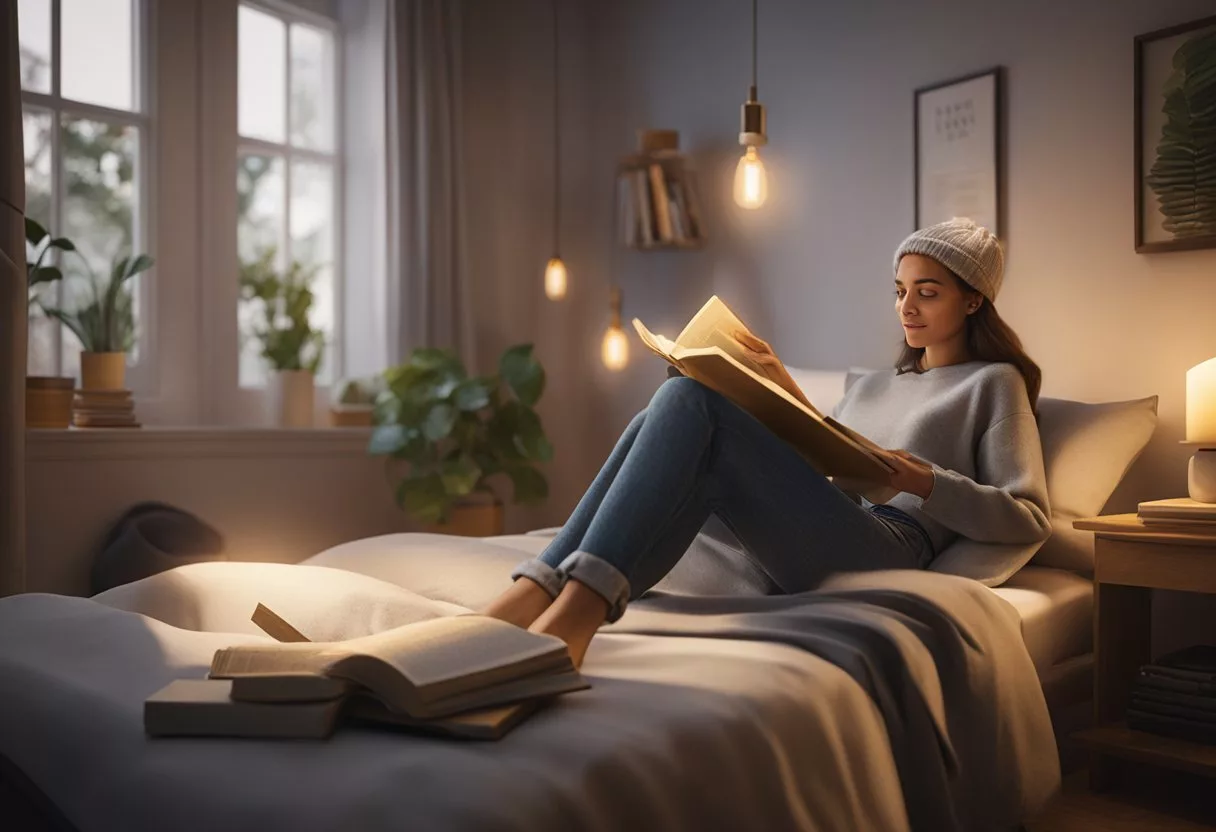The G-spot is a controversial topic in the world of sexual pleasure. Some people believe it to be a highly sensitive area inside the vagina that can lead to intense orgasms, while others claim it doesn’t exist at all. Despite the debate surrounding its existence, the G-spot remains a topic of interest for many people seeking to enhance their sexual experiences.

Anatomy and Location are important factors to consider when discussing the G-spot.
According to some experts, the G-spot is located on the front vaginal wall, about two inches inside the vagina. It is said to be a small, spongy area that can be stimulated to produce intense sensations. However, not all women may have a G-spot or may not be able to locate it easily.
Stimulation Techniques are also a crucial aspect of exploring the G-spot.
Some people claim that a “come hither” motion with the fingers or a curved sex toy can help stimulate the area. However, it’s essential to note that every person’s body is different, and what may work for one person may not work for another. It’s important to communicate with one’s partner and explore different techniques to find what works best for them.
Key Takeaways
- The existence of the G-spot is still a matter of debate.
- The G-spot is said to be located on the front vaginal wall, about two inches inside the vagina.
- Stimulation techniques vary and may require communication and exploration with one’s partner.
Anatomy and Location

Vaginal Wall and Erogenous Zones
The vagina is an elastic, muscular canal that extends from the cervix to the vulva. It is lined with mucous membranes and contains numerous nerve endings, blood vessels, and glands.
The anterior vaginal wall, which is the front wall of the vagina, contains several erogenous zones, including the Grafenberg spot (G-spot), clitoral bulbs, and paraurethral glands. Stimulation of these areas can lead to sexual arousal and orgasm.
The Gräfenberg Spot
The Grafenberg spot, or G-spot, is a highly sensitive area located on the anterior vaginal wall, about 5-8 cm (2-3 in) up from the vaginal opening and just behind the pubic bone. It is characterized as an erogenous area of the vagina that, when stimulated, may lead to strong sexual arousal, powerful orgasms, and potential female ejaculation. However, it’s important to note that the existence and location of the G-spot is still a topic of debate among researchers and healthcare professionals.
Clitoral Network and Erectile Tissue
The clitoris is a highly sensitive and erectile organ located at the front of the vulva, above the vaginal opening. It contains two corpora cavernosa, which are erectile tissue structures that fill with blood during sexual arousal, causing the clitoris to become erect.
The clitoral bulbs are also located on the anterior vaginal wall, and are connected to the clitoris by a network of nerves and blood vessels. Stimulation of the clitoris and its associated structures can lead to intense sexual arousal and orgasm.
In summary, the female genital anatomy contains several erogenous zones that can be stimulated for sexual pleasure, including the G-spot, clitoral bulbs, and paraurethral glands.
While the existence and location of the G-spot is still a topic of debate, many women report experiencing sexual pleasure from stimulation of this area. Understanding the anatomy and location of these structures can help individuals explore and enhance their sexual experiences.
Stimulation Techniques

Manual Stimulation
When it comes to manual stimulation of the G-spot, using the fingers is the most common technique.
The receiver can either do it themselves or their partner can do it for them. The key is to start slow and gradually increase pressure and speed.
The G-spot is typically located about two inches inside the vagina, so it’s important to use a “come-hither” motion with the fingers to apply pressure to the front vaginal wall.
Experimenting with different techniques and pressure levels can help the receiver find what works best for them.
Sex Toys and Accessories
Sex toys designed for G-spot stimulation can be a great addition to manual stimulation.
These toys are typically curved to fit the shape of the vagina and can provide more targeted pressure on the G-spot.
There are a variety of sex toys available, including vibrators, dildos, and G-spot stimulators. It’s important to choose a toy that is comfortable and fits the receiver’s preferences. Using a water-based lubricant can also enhance the experience.
Sexual Positions for G-Spot Access
Certain sexual positions can provide better access to the G-spot during penetrative sex.
Positions that allow for deeper penetration, such as doggy style or missionary with the hips elevated, can provide more pressure on the G-spot.
Other positions, such as cowgirl or reverse cowgirl, can allow the receiver to control the angle and pressure of penetration.
Experimenting with different positions can help the receiver find what works best for them.
Sexual Response
When it comes to sexual response, there are several factors that can contribute to a satisfying sexual experience. Sexual arousal and lubrication are important for both men and women, and can help to enhance pleasure and reduce discomfort during sex.
Arousal and Lubrication
Arousal is the first step towards sexual response. It involves a combination of physical and emotional stimulation, and can be triggered by a variety of factors, including touch, sight, sound, and smell.
Sexual arousal leads to increased blood flow to the genitals and can result in vaginal lubrication in women.
Lubrication is important for comfortable and pleasurable sex, as it helps to reduce friction and discomfort.
Women may experience natural lubrication during sexual arousal, but additional lubrication can also be used to enhance sexual pleasure.
Orgasm: Clitoral vs G-Spot
Orgasm is the peak of sexual response, and can be achieved through clitoral or G-spot stimulation.
Clitoral orgasms are achieved through stimulation of the clitoris, which is a highly sensitive and erogenous zone located at the top of the vulva.
G-spot orgasms, on the other hand, are achieved through stimulation of the G-spot, which is located inside the vagina on the front vaginal wall.
While both types of orgasms can be intensely pleasurable, some women may find that they prefer one over the other.
It is also possible to achieve both clitoral and G-spot orgasms simultaneously, which can result in a more intense and powerful orgasm.
Squirting and Female Ejaculation
Some women may experience female ejaculation, also known as squirting, during sexual activity.
This involves the release of fluid from the Skene’s glands, which are located near the G-spot. While the exact nature and composition of this fluid is still a topic of debate among researchers, it is generally agreed that female ejaculation can be a pleasurable and intense experience for some women.
Psychological Aspects

Many people believe that the G-spot is a physical entity that can be located and stimulated for sexual pleasure. However, the psychological aspects of the G-spot cannot be ignored. Communication and self-exploration are crucial for discovering and enhancing sexual pleasure.
The Role of Communication
Communication is key to a satisfying sexual experience, including the search for the G-spot.
Partners should feel comfortable discussing their desires and preferences with each other. This includes discussing what feels good and what doesn’t, as well as any concerns or questions they may have.
Sexologists recommend that couples engage in open and honest communication to enhance their sexual experiences.
Self-Exploration and Masturbation
Self-exploration and masturbation are also important for discovering the G-spot.
Masturbation allows individuals to explore their bodies and discover what feels good. Through trial and error, individuals can learn what works for them and communicate this to their partners.
However, it’s important to note that not everyone may experience pleasure from G-spot stimulation.
Sexual pleasure is subjective and can vary from person to person.
It’s important to focus on what feels good and not feel pressure to conform to societal expectations.
In addition, sexual stimulation is not limited to the G-spot. Sexual positions and other erogenous zones can also be explored to enhance sexual pleasure.
It’s important to be open to trying new things and communicating with one’s partner to ensure a satisfying sexual experience.
Cultural and Historical Perspective

Ernst Gräfenberg and Historical Recognition
The concept of the G-spot was first introduced by Ernst Gräfenberg, a German gynecologist, in the 1950s.
In his research, Gräfenberg described a sensitive area inside the vagina that, when stimulated, could lead to intense orgasms. However, his work was not widely accepted at the time, and it was not until the 1980s that the term “G-spot” became popularized.
Despite the lack of recognition during his lifetime, Gräfenberg’s work has had a lasting impact on the study of female sexuality. Today, the G-spot is recognized as a legitimate anatomical structure, and its existence is supported by numerous studies.
Modern Research and Studies
In recent years, there has been a renewed interest in the G-spot. A growing body of research aims to understand its function and significance.
One 2017 study found that the G-spot is a distinct anatomical structure. It is separate from the clitoris and other genital areas.
Despite this progress, many misconceptions still surround the G-spot. Some people believe that every woman has a G-spot, or that it is the key to achieving female orgasm. However, research suggests that sensitivity to G-spot stimulation can vary greatly from person to person. It is just one of many factors that can contribute to sexual pleasure.
To help dispel these myths and promote a better understanding of female sexuality, some experts recommend working with a sex coach or therapist. These professionals can provide guidance and support for individuals looking to explore their own bodies and enhance their sexual experiences.
Practical Advice

Finding the G-Spot
Locating the G-spot can be a challenge for some individuals, as it is not always easily identifiable. However, it is typically located on the front vaginal wall, about 2-3 inches from the vaginal opening. Some people describe it as feeling slightly rougher or more textured than the surrounding tissue. Others report that it feels like a small bump or a bean-shaped area.
Experimenting with different positions, such as cowgirl or doggy-style, may help individuals locate the G-spot more easily.
Navigating Challenges
While some individuals may have no trouble locating the G-spot and experiencing pleasure through stimulation, others may encounter challenges.
It is important to communicate with partners about preferences and physical responses to stimulation. Some individuals may find that internal stimulation of the G-spot is uncomfortable or even painful. In these cases, shallow penetration or stimulation of other erogenous zones may be more enjoyable.
It is also important to note that not all individuals may experience orgasm through G-spot stimulation alone. Experimenting with different techniques and positions may help individuals find what works best for them.
Frequently Asked Questions
What is the anatomical basis of the so-called pleasure zone in female physiology?
The G-spot is a small, sensitive area located on the front wall of the vagina, about two inches in. It is believed to be an erogenous zone that, when stimulated, can lead to intense sexual pleasure and even orgasm. The G-spot is thought to be a part of the clitoral network, extending internally along the vaginal wall.
Can the sensitivity of this area vary among individuals?
Yes, the sensitivity of the G-spot can vary among individuals. Some women may find it extremely pleasurable when stimulated, while others may not experience any sensation at all. It is important to remember that every woman’s body is unique and may respond differently to various forms of stimulation.
What techniques are recommended for locating and stimulating this zone?
There are several techniques that can be used to locate and stimulate the G-spot. These include manual stimulation with fingers or a sex toy, and certain sexual positions that allow for deeper penetration.
It is important to communicate with one’s partner and experiment with different techniques to determine what works best for each individual.
Is there scientific evidence to support the existence of this sensitive area?
While there is ongoing debate in the scientific community about the existence and location of the G-spot, many women report experiencing pleasure from stimulation of this area.
Some studies have suggested that the G-spot may be a distinct anatomical structure, while others have found no evidence to support its existence.
How does the stimulation of this area affect sexual pleasure?
Stimulation of the G-spot can lead to intense sexual pleasure and even orgasm. Some women report experiencing a different type of orgasm when the G-spot is stimulated, characterized by a deeper, more intense sensation. However, it is important to remember that sexual pleasure is subjective and can vary greatly among individuals.
Are there any misconceptions about the role of this area in sexual health?
Many misconceptions exist about the G-spot and its role in sexual health. Some people believe that all women have a G-spot and that stimulation of this area is necessary for sexual satisfaction. However, sexual pleasure is complex and multifaceted, and there is no one “right” way to experience pleasure. It is also important to note that the G-spot is not a medical or diagnostic term. Its existence and importance in sexual health remain the subject of ongoing debate and research.